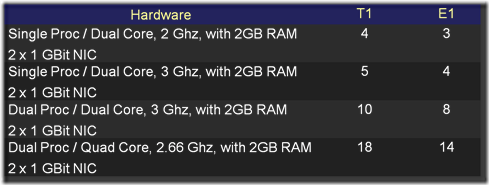Mediation Server and Erlang
One of the best ways to estimate the number of channels needed to handle your call workload is to use an Erlang traffic model. This well-known call-statistics calculation method helps you to determine how many channels you need to support call traffic and gives you a good starting point for investigating your deployment requirements.[1] Keep in mind these are great tools but working with your voice partner can help determine proper sizing for your OCS deployment.
Erlang calculations use a unit of measurement called the Erlang. An Erlang describes traffic through telephony equipment (such as incoming calls into a phone switch or PBX).
1 Erlang = 1 continuous 3600 second (60 minute) call
To determine the maximum number of Erlangs that you need to accommodate, multiply the number of calls during the busy hour (B)[2] by the average call length in seconds (L), and then divide by 3600:
Erlangs = (B*L)/3600
For example, if you estimate that your deployment will receive 1000 calls during the busy hour and the average length of a call is two minutes (120 seconds), the estimated number of Erlangs is determined as:
(1000*120)/3600 = 33.3 Erlangs
When you have established the number of Erlangs your deployment will process, you can use an Erlang traffic calculation to determine the number of required telephony channels. The Erlang traffic formula is a mathematical algorithm that incorporates the number of Erlangs you estimated plus a percentage of blocked calls (or busy signals) that you think is acceptable. For example, if you take the 33.3 Erlangs from above and you can tolerate 1 percent call blockage, the Erlang traffic calculation determines that your deployment needs to scale to 45 concurrent channels.
In OCS the Mediation server needs to be sized against the gateway for call traffic.
Start with campus average busy hour Erlang from/to OCS users
For small deployment assume all calls across GW link; proportion will decrease with size of deployment
Allow resources for call forwarding, simultaneous ringing of mobile (tromboning)
Suggested orders of magnitude
- Light usage (1 call/bhr) -> 1 channel per 15 users
- Medium usage (2 calls/bhr) -> 1 channel per 10 users
- Heavy usage (3+ calls/bhr) -> channel per 5 users
Mediation Server is key in sizing!!!!
Mediation Server supports about 230 simultaneous calls with dual proc dual core this represents about 2300 “medium” users. T1 carries 23 calls so one Mediation Server can support about 10 T1 (8 E1)
[1] More about the Erlang methods including calculators are available online at https://www.erlang.com/.
[2] The busy hour (B) is the hour of operations during which the highest number of phone calls are arriving into your call center.
Comments
- Anonymous
January 01, 2003
One of the best ways to estimate the number of channels needed to handle your call workload is to use
